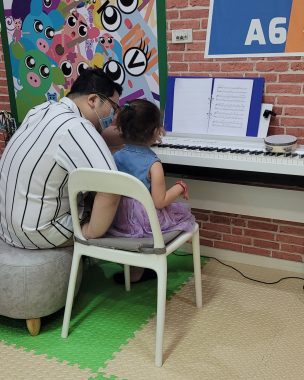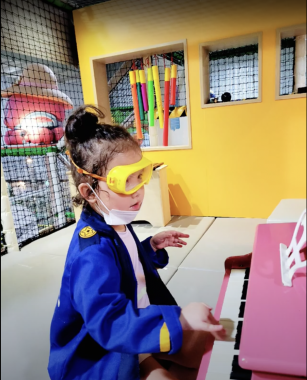How Music Therapy Has Benefited Our AADC-deficient Daughter
Music has been key in helping a young girl develop various skills
Written by |

Today, our daughter, Rylae-Ann, sits at a piano and explores the sounds she can make, then jumps off the stool and heads to the xylophone to grab a mallet, which makes the magical sounds flow out.
Music therapy was a strategy my wife used with her special education classes. The multisensory teaching approach adds motivation and excitement to a learning experience and can capture the elusive attention of any child.
As we tried to support our daughter the best we could once we learned she had a rare disease known as aromatic l-amino acid decarboxylase (AADC) deficiency, we had to rely on organizations that supported children with similar symptoms. Music therapy is a well-established technique that has benefited autistic children with a wide range of cognitive and emotional challenges and improved their ability to function.

Rylae-Ann works with a licensed music therapist to help better manage her behavior. (Courtesy of Richard E. Poulin III)
When Rylae-Ann was about 6 months old, we tried our best to give her a normal childhood. We took her to a indoor playground with music class, but it did not work out. Later, we learned this was due to her anxiety. However, I wish we hadn’t given up on it since it can improve sensory processing issues.
Later, when we revisited the music class, we saw that she just needed time to slowly get used to the experience. It became a regular activity that we added to our play-based education sessions with her.
Our experience tells us that prior education can improve the results of gene therapy. The best part about music therapy is that it can be beneficial for AADC-deficient children both before and after gene therapy. Music therapy was one of the components that supported cognitive improvement while we waited for a clinical trial. Over time, we learned that there are several approaches.

Rylae-Ann enjoys sessions that combine play-based learning and music therapy approaches. (Courtesy of Richard E. Poulin III)
Music therapy approaches
There are several different approaches to music therapy. I wouldn’t say one is better than another. Instead, go with the approach that best meets your child’s needs. There are pros and cons to each, but ultimately, the one that is most enjoyable for your child is the best choice.
For our daughter, it was cognitive behavioral music therapy (CBMT) and Nordoff-Robbins music therapy. CBMT is helpful for behavior management. It is structured, and Rylae-Ann was able to relax due to the predictable schedule. It has elements of music, dance, singing, and instruments.
Nordoff-Robbins music therapy is a much more creative approach. It took Rylae-Ann some time to get used to the random sounds. However, creativity is an essential skill in the curriculums my wife and I provide our students in our teaching roles. We wanted to share the same benefits with our daughter, so gradually, we helped her become more comfortable with self-expression.
Regardless of the approach, music is a beneficial medium to add to any play session with your child. Beyond teaching and being consumed with battling Rylae-Ann’s rare disease, it offers everyone an escape to simply relax and enjoy the music.

Rylae-Ann explores self-expression and builds creativity with music therapy. (Courtesy of Richard E. Poulin III)
Note: AADC News is strictly a news and information website about the disease. It does not provide medical advice, diagnosis, or treatment. This content is not intended to be a substitute for professional medical advice, diagnosis, or treatment. Always seek the advice of your physician or other qualified health provider with any questions you may have regarding a medical condition. Never disregard professional medical advice or delay in seeking it because of something you have read on this website. The opinions expressed in this column are not those of AADC News or its parent company, Bionews, and are intended to spark discussion about issues pertaining to aromatic l-amino acid decarboxylase deficiency.






Leave a comment
Fill in the required fields to post. Your email address will not be published.